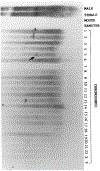Chromosomal localization of the human renal sodium phosphate transporter to chromosome 5: implications for X-linked hypophosphatemia
- PMID: 8047391
- PMCID: PMC6085749
Chromosomal localization of the human renal sodium phosphate transporter to chromosome 5: implications for X-linked hypophosphatemia
Abstract
Hypophosphatemic vitamin D-resistant rickets, an X-linked dominant disorder, is the most common form of vitamin D-resistant rickets in humans (McKusick number 307800). Biochemically, these patients exhibit hypophosphatemia due to a defect in the renal tubular reabsorption of phosphate. The human cDNA encoding for the renal phosphate transporter has been recently cloned using the expression system in the Xenopus laevis oocytes. Because hypophosphatemic vitamin D-resistant rickets has an X-linked mode of transmission, we hypothesized that the gene encoding the renal phosphate transporter might map to the X chromosome. In this report, we determined the chromosomal localization of the human renal phosphate transporter using three independent methods. First, DNA from somatic cell hybrid panels was examined by Southern blotting for the phosphate transporter. Second, the polymerase chain reaction was used to amplify DNA from somatic cell hybrids. Third, fluorescent in situ hybridization was used to sublocalize the renal phosphate transporter. All three methods localized the renal phosphate transporter to chromosome 5q13. Our results indicate that either derangement of a gene other than the phosphate transporter gene that is encoded on chromosome 5 is responsible for X-linked hypophosphatemic rickets or, alternatively, a gene encoded on the X chromosome has an epistatic effect on the expression of the renal phosphate transporter on chromosome 5.
Figures



Similar articles
-
Molecular cloning, functional expression, tissue distribution, and in situ hybridization of the renal sodium phosphate (Na+/P(i)) transporter in the control and hypophosphatemic mouse.FASEB J. 1994 Aug;8(11):862-8. doi: 10.1096/fasebj.8.11.8070635. FASEB J. 1994. PMID: 8070635
-
Chromosome assignments of genes for human Na(+)-dependent phosphate co-transporters NaPi-3 and NPT-1.Tokushima J Exp Med. 1995 Jul;42(1-2):5-9. Tokushima J Exp Med. 1995. PMID: 7570593
-
High resolution mapping of the renal sodium-phosphate cotransporter gene (NPT2) confirms its localization to human chromosome 5q35.Pediatr Res. 1997 May;41(5):632-4. doi: 10.1203/00006450-199705000-00005. Pediatr Res. 1997. PMID: 9128283
-
X-linked hypophosphatemic rickets and the murine Hyp homologue.Am J Physiol. 1995 Mar;268(3 Pt 2):F357-62. doi: 10.1152/ajprenal.1995.268.3.F357. Am J Physiol. 1995. PMID: 7900834 Review.
-
Novel phosphate-regulating genes in the pathogenesis of renal phosphate wasting disorders.Pflugers Arch. 2002 Jun;444(3):317-26. doi: 10.1007/s00424-002-0839-4. Epub 2002 Apr 23. Pflugers Arch. 2002. PMID: 12111239 Review.
Cited by
-
Hypophosphatemic rickets: easy to diagnose, difficult to treat.Indian J Pediatr. 1999 Nov-Dec;66(6):849-57. doi: 10.1007/BF02723852. Indian J Pediatr. 1999. PMID: 10798150
References
-
- Borowitz SM, Ghishan FK 1989. Phosphate transport in human jejunal brush border membrane vesicles. Gastroenterology 96:4–10 - PubMed
-
- Borowitz SM, Ghishan FTC 1985. Maturation of jejunal phosphate transport by rat brush border membrane vesicles. Pediatr Res 19:1308–1312 - PubMed
-
- Walling MW 1977. Intestinal Ca and phosphate transport: differential responses to vitamin D3 metabolites. Am J Physiol 233:E488–E494 - PubMed
-
- Danisi G, Van Os CH, Straub RW 1984. Phosphate transport across brush border and basolateral membrane vesicles of small intestine. Prog Clin Biol Res 158:229–234 - PubMed
-
- Peterlik M, Wasserman RH 1978. Effect of vitamin D on transepίthelial phosphate transport in chick intestine. Am J Physiol 234:E379–E388 - PubMed
Publication types
MeSH terms
Substances
Grants and funding
LinkOut - more resources
Full Text Sources
Molecular Biology Databases
